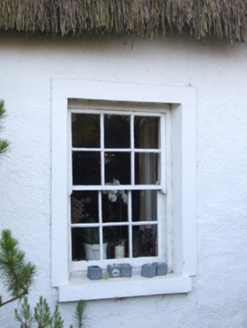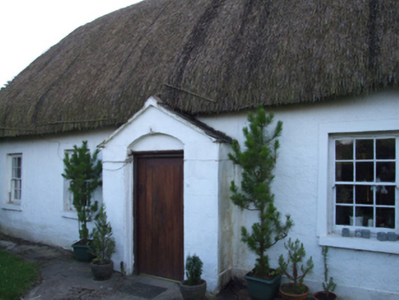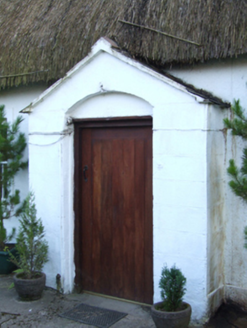Survey Data
Reg No
15702214
Rating
Regional
Categories of Special Interest
Architectural, Social
Original Use
House
In Use As
House
Date
1700 - 1840
Coordinates
316557, 141114
Date Recorded
28/08/2007
Date Updated
--/--/--
Description
Detached four-bay single-storey lobby entry thatched house with dormer attic, extant 1840, on a rectangular plan off-centred on single-bay single-storey gabled windbreak. Extended, 1860, producing present composition. Occupied, 1901; 1911. Hipped oat thatch roof on collared timber construction with exposed wire stretchers to degraded ridge having exposed wire scallops, red brick Running bond off-central chimney stack having corbelled stepped capping supporting yellow terracotta pots, and exposed bamboo stretchers to eaves having exposed wire scallops. Limewashed lime rendered or roughcast battered walls on rendered plinth with rendered "bas-relief" strips to corners. Square-headed off-central door opening in camber- or segmental-headed recess with concealed dressings framing replacement timber boarded door. Square-headed window openings with concrete or rendered sills, and rendered "bas-relief" surrounds framing six-over-six timber sash windows having part exposed sash boxes. Square-headed window openings (gables) with concrete or rendered sills, and rendered "bas-relief" surrounds framing two-over-two timber sash windows having part exposed sash boxes. Set back from line of road in landscaped grounds with hedge boundary to perimeter centred on wrought iron gate.
Appraisal
A house identified as an important component of the vernacular heritage of County Wexford by such attributes as the rectilinear lobby entry plan form off-centred on a characteristic windbreak; the construction in unrefined local materials displaying a battered silhouette with sections of "daub" or mud suggested by an entry in the "House and Building Return" Form of the National Census (NA 1901; NA 1911); the somewhat disproportionate bias of solid to void in the massing; and the high pitched roof showing an oat thatch finish. Having been well maintained, the elementary form and massing survive intact together with substantial quantities of the historic or original fabric, both to the exterior and to the interior, thus upholding the character or integrity of a house making a picturesque visual statement in a rural street scene.





